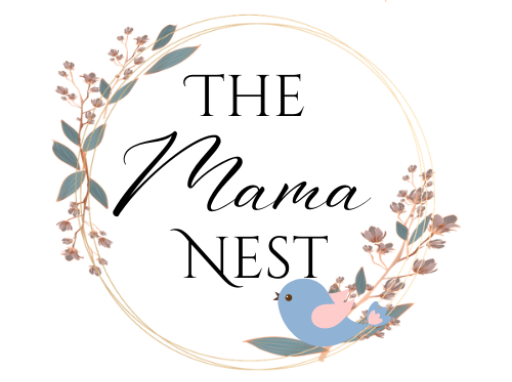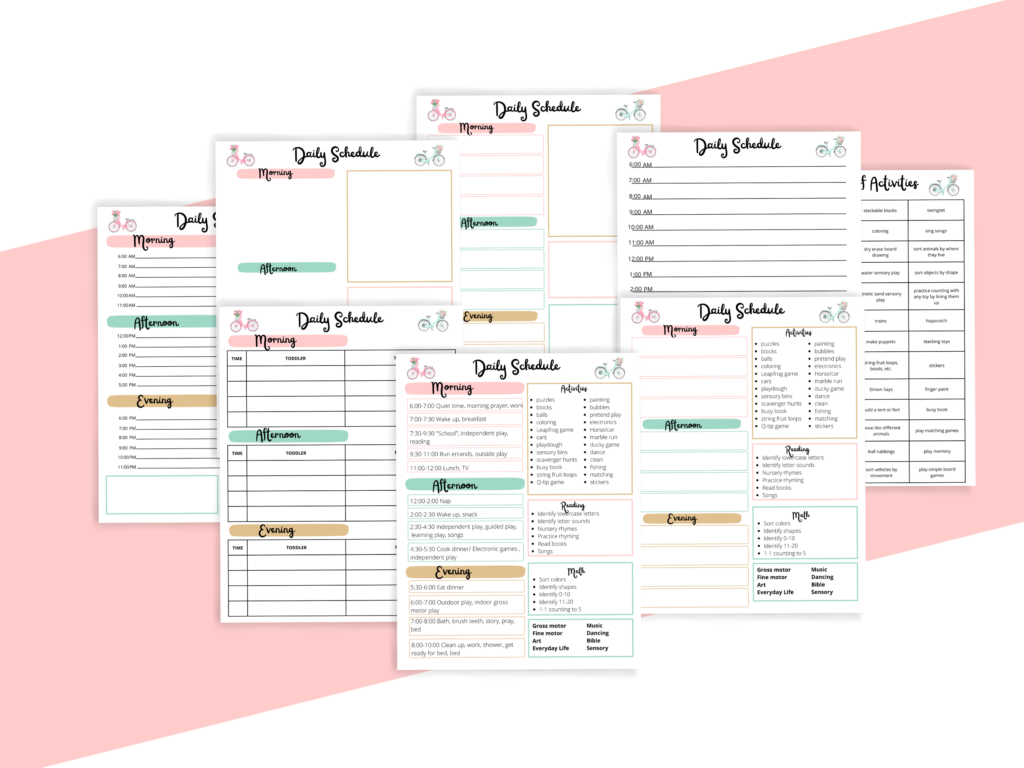How to Create a Toddler Daily Schedule

Oh the blessed toddler years! Chances are that you are reading this post because you have one or two little ones in these interesting years of their lives. Toddlerhood is such a beautiful chaotic, day-to-day kind of living. Some days fly by and others crawl to the finish line. Keeping track with a toddler schedule can help.
Let me first say that I’m in a love-hate relationship with the toddler years. My oldest is two and a half, and it’s been a rollercoaster. On the one hand, Nathaniel is learning so much and so quickly that I can hardly keep up with him! Sometimes he does or says things that I don’t even know where he learned them from! Like the other day, he was singing to a captive audience that included me and his grandparents. When he was done, he bowed. We laughed at the cuteness, but none of us have ever shown him that! We concluded Mickey Mouse Clubhouse had to be the culprit. On the other hand, the food he liked yesterday and forever he suddenly despises the very sight of, and how dare I smiled at him when he woke up this morning.
My point is that toddlerhood is a special few years of vast learning, and when one is learning so much so quickly, it’s easy to get lost in trying to keep your toddler occupied. That’s why having a schedule for your toddler, even a loose one can bring some semblance of order to the chaos.
Now don’t stress! A toddler schedule doesn’t need to be an extensive breakdown of every minute of the day. A simple block schedule to help keep you on track may be all you need!

What is a toddler schedule?
A toddler schedule is like any other schedule, except it’s specially tailored to a toddler’s needs. Instead of work, there’s play. Instead of meetings, there’s playdates.
As a former kindergarten teacher, I understand the importance of a schedule. For one, it helps with routines. Not only did it keep the kids busy, but it also helped me stay on track throughout the day. And a great benefit was that some days I’d get busy and my students would come up and remind me about what was next in our day.
So why have a schedule for a toddler?
If you’re anything like me, a flegmatic kind of personality, then you may be asking yourself this very question. Why bother when the days get rearranged constantly anyway? Your toddler will nap and sleep and eat and play around the same times every day, so why even attempt to put it on paper?
Well let me tell you why- this kind of living as a stay-at-home mama can easily become chaotic, not just for you but for your toddler as well. Young children love routines and knowing what’s expected. Using a schedule for yourself keeps you on track, but giving your child a visual schedule can help keep him or her on track as well!

How to get started with creating a toddler schedule.
If you don’t have a schedule already, then the easiest way to start with creating a schedule is to look at what you do every day. Does your toddler wake up around the same time each day? What about breakfast, lunches, naps? Do you start your bedtime routine around the same time each night? Once you look at these natural routines you already have, you can start building around them.
For example, the bones of your schedule may look something like this:
7:50-8:10 Wake up Time
8:45 Breakfast
12:00 Lunch
12:30 Nap
2:30 Snack
6:00 Dinner
8:00 Bedtime
Next, you need to fill in all of the gaps. Think about when your toddler plays independently the best. When is it easiest for you to get out of the house? Is there a preference for a certain time of day to play outside? When planning my days, I try to get out of the house at least once, whether that means going to the store, driving around the block, or playing outside. And this activity is usually best for us in the mornings after breakfast. I know that reading stories to my toddler is important, as well as having him occupied while I cook dinner. So, a full toddler schedule make look like this:
7:50-8:10 Wake up Time. Allow some flexibility here.
8:10-8:45 Independent play.
Puzzles, a quiet box, or a sensory box would be great independent activities while you are cooking or making breakfast. If your toddler hasn’t been exposed to a sensory box yet, any other game or toy they like to play with by themselves would be great.
8:45 – 9:15 Breakfast
9:15-11:15 Outside play, gross motor play, or outing from the house.
This is where your errand running could be. If you don’t need to go anywhere, then consider playing outside during this time. You don’t have to stay outside the entire 2 hours. Part of this time could be getting dressed for the day, putting on shoes, and then coming back in the house and cooling off with a popsicle or such. Make it work for you and your family!
11:15-12:00 Reading time.
This could be a quiet, cool down time after your outside play or errand running where your toddler sits with some chosen books while you prepare lunch. You could also do some easy, calming tasks like coloring, drawing, or using a marker board or chalkboard.
12:00-12:30 Lunch
12:30-2:30 Nap
If your toddler doesn’t nap, don’t worry! This could be your toddler’s quiet time. Give them a quiet bin full of activities that don’t create a lot of noise, so nothing electronic.
2:30-2:45 Snack
2:45-5:00 Play (here you could go outside again, run an errand, or play indoors)
During this time you could go outside again to kill some energy, run more errands, or play indoors. This would be a good time for gross motor play! Jump on an indoor trampoline, kick a ball, or throw a ball into a basket to help drain some of that pent up toddler energy!
5:00-6:00 Indoor play
Pretend play, playing with cars, or building with blocks are all great indoor activities for your toddler while you get dinner ready.
6:00-6:30 Dinner
6:30-7:00 Screen Time (mom cleans up kitchen)
If you don’t do screen time, then have your toddler do a favorite activity or a quiet time activity while you clean up the kitchen. This would also be a great time for your toddler to spend with siblings or Dad. If Dad cleans up after dinner, then you spend time with your toddler. Anything you do with them will be time well spent!
7:00-7:30 Bath time, brush teeth
7:30-8:00 Read favorite nighttime books, pray, tuck in.
If you need some help with reading to your toddler, check out my post on how to read to your child. You’ll find simple instructions with recommendations for the types of books for your child depending on their age!
8:00 Bedtime
And that’s it! A simple outline of your day to help keep you (and your toddler) on track!
Create Your Own Toddler Schedule!
Use these printable schedules to help plan your toddler’s day! Included are 100 activity ideas for you to plan for your toddler!
Things to keep in mind…
- A toddler schedule isn’t something set in stone, nor is it something that is the exact same for every family. My husband works second shift, so when he gets home, he likes to see the kids, which means they have a later bedtime and later wake up time. But for now, that works for us.
- You may visit grandma’s house every Tuesday at 3 in the afternoon. That’s fine! Put it on your schedule and then work around it.
- Plan ahead for activities. Go ahead and check the weather for the week to see about rain or snow. If there’s any in the forecast, prepare new (simple) activities to keep your toddler engaged on those days or plan to visit a local indoor playground for your outing.
- Stay flexible on your plan. Keeping a schedule for your toddler is great, but let’s be honest: things happen. It’s best if you remember to keep some flexibility in your day-to-day plans!
Quick answers
Good luck!
Creating a toddler schedule isn’t very hard once you get started. All it takes is a dash of discipline and a pinch of planning to get started! Having a schedule for your toddler can not only be beneficial for you as a mama, but also help your toddler prepare for the day by knowing what comes next. If you need help starting your day on the right foot, the check out my 7 Secrets to a More Productive Day post!
If you have any tips as to what has worked for you when creating a toddler schedule, please share below! I’d love to read any suggestions!


